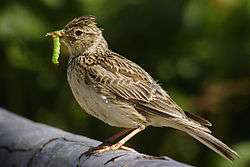Lark (person)

A lark, early bird, morning person or, in Scandinavian countries, an A-person, is a person who usually gets up early in the morning and goes to bed early in the evening. The lark (bird) starts its day very early, which explains the choice of the word lark for people who may sleep from around 10 p.m. to 6 a.m. or earlier. Human "larks" tend to feel most energetic just after they get up in the morning. They are thus well-suited for working the day shift.
The opposite of the lark is the owl, often awake at night. A person called a night owl is someone who usually stays up late and may feel most awake in the evening and at night. Researchers have traditionally used the terms morningness and eveningness to describe these two phenotypes.[1]
Charting chronotypes
Till Roenneberg, a chronobiologist in Munich, has mapped the circadian rhythms of more than 220,000 people. Biological processes, including sleep-wake patterns, that display an oscillation of about 24 hours are called circadian rhythms. According to Roenneberg, the distribution of circadian rhythms spans from the very early to the very late chronotypes, similarly to how height varies from short to tall.
As circadian rhythm is independent of the number of hours of sleep a person needs, Roenneberg calculates the rhythm based on the midpoint of the sleep period. A person who goes to bed at midnight and rises as 8 thus has the same chronotype as a person who goes to bed at 1 a.m. and rises as 7; the midpoint of sleep is 4 a.m. for both individuals.
People with early chronotypes, will usually not be able to "sleep in", even if they have stayed up later than usual. Despite feeling refreshed in the morning and being accommodated by much of the societal framework around them, many "larks" feel hampered socially, as much of social life takes place in the evening.
People with late chronotypes go to bed late and rise late. Forced to arise earlier than their circadian rhythm dictates, they have a low body temperature and may require a few hours to feel really awake. They are unable to fall asleep as early as "larks" can.
Prevalence
Discussions and studies about the prevalence of morning, evening and indifferent or intermediate chronotypes use different criteria and come to different results. Some ask what time people do go to sleep and wake up—others ask what time people would prefer to. One survey of over 400 adults showed approximately 15% morning people, 25% evening people, and 60% intermediates.[2]
See also
References
- ↑ Horne JA, Östberg O (1976). "A self-assessment questionnaire to determine morningness-eveningness in human circadian rhythms". Int J Chronobiol. 4 (2): 97–110. PMID 1027738.
- ↑ Schur, Carolyn (1994). "excerpt". Birds of a Different Feather. Saskatoon, Canada: Schur Goode Associates. ISBN 0-9698190-0-5. Retrieved 2009-07-20.